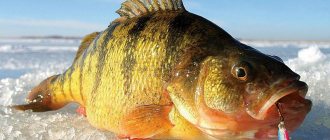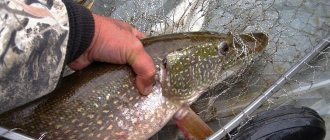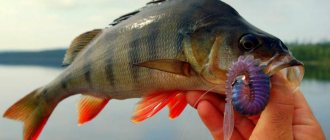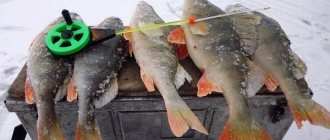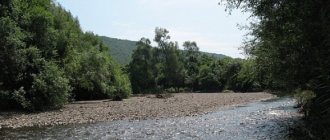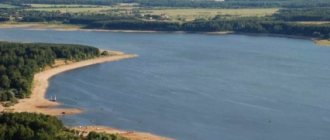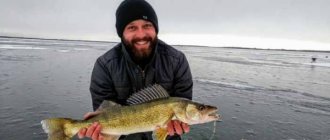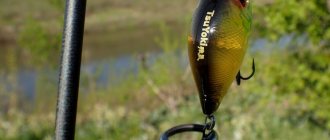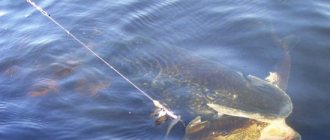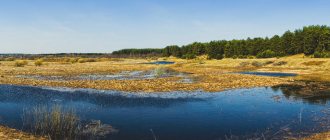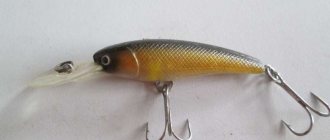Catching large perch is determined by a number of characteristic features. So, you should take into account the topography of the bottom and vegetation, adhere to certain recommendations regarding the time of day and the very place where large perch will be caught. Perch is represented in most bodies of water, but a really large representative of this species is a real find for any fan of casting a fishing rod.
River perch is a representative of the family of so-called ray-finned fish, lives everywhere, from Karelia to the Yenisei and Lena, where in the Far East it is replaced by other species of ray-finned predatory fish, which are very reminiscent, both in appearance and in habits, of the ordinary striped greenish color of their small Western relative.
In the Western Hemisphere, perch are much more common. In most reservoirs, the number of “minke whales” can exceed any other species combined. This significant prevalence is due to the predatory nature and rapid reproduction of this species. Perch eats up to 90% of the young of other fish species, which gives it hegemonic status in an area of a lake, river, pond or reservoir.
In stagnant water, striped predators behave most boldly, feeling the strength and impunity for their actions, flocking into real “armadas” of up to 100-140 tails, causing irreparable damage to the population of all other species, including their own, since the perch is also known and addiction to such a repulsive phenomenon as cannibalism.
Perches do not live in fast-flowing rivers. They prefer more extensive waters, like the Volga and Dnieper, where there is room to develop their activities at full capacity. However, in such reservoirs, perches no longer try to gather as large a squad as possible.
Instead, they strive for self-sufficiency and a solitary lifestyle. Medium-sized individuals, out of habit, keep in schools of up to 20 tails, but rare “giants” weighing up to two kilograms (river perch can hardly grow larger) try to occupy the most secluded place for their lair, closer to the bottom, in the shade.
The body structure of the “minke whale” and its characteristic features do not allow it to be confused with any other type of freshwater fish. He has a number of individual traits, of which there are not many, but nevertheless, they immediately catch the eye, namely:
- hump on the back;
- body height corresponds to one third of its length;
- vertical dark stripes.
Conventionally, there are two main types of river perch. One of them is small, agile, lives in a flock, is of no interest alone, but during the so-called perch “cauldrons”, a lucky fisherman will be able to fill two or three buckets with these unlucky striped pranksters in a few hours.
They compensate for their small body size with the number of individuals, which in a separate flock can be measured in the hundreds. They hunt together: they swim into shallow water and raid the fry, surrounding them, which causes a real seething, which is immediately noticed by seagulls and nearby fishermen. Small perches grow for a very long time and rarely reach sizes of 200-300 grams.
Another type of perch is the “humpback fish”. It differs from its smaller brother in its impressive size, overly protruding hump, topped with a high spiky crest, and in general, its entire appearance clearly speaks of its extremely predatory nature. Dangerous, daring, his whole appearance resembles a kind of “punk” that disturbs the peace of rivers, lakes and other freshwater bodies. This subspecies grows very quickly and can reach a size of 300 grams in a year.
A characteristic feature of the interaction between two conventional species is the fact that up to a certain point, both small and large perches live together and act together. It is possible that even future respectable-sized “humpback whales” have their place in large lake schools of striped pranksters, however, in such conditions it will be extremely problematic for them to grow, from which they retire into free swimming.
Indeed: the larger the flock, the smaller its individual members. After all, in order to gain weight of one kilogram, a perch will need to absorb fish with a total weight of up to four kilograms, when such a thing is practically impossible in conditions of constant life with a school.
Therefore, subsequently, individual representatives of the “minke whales” stand out from the general mass, occupy a more hidden position, somewhere in the shadow of the coastal reed waters, and begin to hunt from cover for the fry swimming past, which, together with crustaceans, tadpoles and insects, form the basis of the diet of any perch, until the individual fully matures, which occurs at 3-4 years of life.
Based on this division, within the framework of this article, fishing for large perch is of interest, i.e. “humpback whale”. This task is not as simple as it might seem at first glance. However, in order to achieve some success in this endeavor, you need to know and follow some rules and recommendations that can significantly facilitate the fishing process itself.
Perch fishing in spring, summer and autumn
Fishing for large perch has a number of differences at different times of the year. For example, in the spring, all types of perches (both large and small) go out hunting: small “sailor fish” in flocks approach the reed thickets, where various species of fish previously spawned in abundance. The “Humpbacks” were always somewhere nearby. However, “joining forces” does not occur and the two species act separately and it is not uncommon for a large perch to dine on its much smaller relatives.
On the other hand, during such a hunt, even initially small perches can gain the required amount of mass, which will begin their transition to another, heavier “weight category,” making them join the ranks of the larger “humpbacks.”
In the second half of May, perch in schools begin to move away from the shores, towards open water. However, large representatives remain in their previous places of deployment, trying to remain in the shadow of creeks, near islands, under stones or in reeds. There they feel quite comfortable and even at ease: prey is caught from time to time, while larger predators rarely swim by.
Thus, large representatives of freshwater perch spend the year round in approximately the same places, which makes catching them a much less difficult process than it could be if they were more mobile and agile by nature.
“Humpback whales” become most active in the autumn, before the arrival of cold winter. At this time, striped predators try to increase as much body fat as possible in order to reduce their activity level in winter. It is in the fall that perch eats a lot and willingly: sometimes you can see its tail sticking out from its mouth, because the esophagus is literally filled to capacity with prey.
Where to look for large perch in winter video
The best time to catch big bass is in winter
To catch a large specimen, you need to know what depth the fish prefer, what distance the perch likes from the surface of the water. The fish visits shallow water areas at dawn or in the evening to get food.
Perch is a predator that eats small relatives; its diet also includes larvae and insects.
In the cold season, it gathers in flocks and descends to the depths to overwinter.
After freezing, the fish begins an active search for food. This period lasts as long as there is a large amount of oxygen in the water. The most difficult time to catch it is in the middle of winter. When using wobblers, silicone baits and metal spoons, catching perch becomes more effective.
After the water level has dropped, the fish tends to go deeper. To do this, it selects places rich in various vegetation, branches and snags, with a muddy or rocky bottom. It prefers activity during daylight hours, but the perch does not bite at night.
With the onset of cold weather, the fish move to bays and bays. It is not easy to lure a predator out of there, but hunger forces it to rise to the surface from time to time in search of food.
The main principles that should be followed when fishing are the ability to wait and the availability of bait. Scented baits are suitable.
Fishing for perch using a fishing rod, bottom line and spinning rod
Perch is one of the most common fish species in almost all bodies of water in Russia and neighboring countries. It is not surprising that he is often the one who gets hooked, even when he is not the one who was caught. The striped dodger shows himself to be an overly greedy and grasping hunter, capable of clinging to prey that is not much smaller than himself. It will never part with the caught catch, so in 90% of cases it manages to fall into the hands of fishermen, while many other types of fish quickly understand what the body is and try to retreat as soon as possible. Perch is not like that - he will go to the very end, never stopping fighting.
Its traits such as stubbornness of character, tenacious grip, low intelligence and excessive appetite make it the easiest prey for any fisherman. You can catch perch using either a simple fishing rod or a bottom fishing line or spinning rod. With the help of the latter, an experienced fisherman alone can significantly reduce the number of “minke whales” in a small individual reservoir.
In order to successfully hook a “humpback whale” from the shore, you will need a regular telescopic fishing rod up to five meters long, equipped with a simple inertia-free reel system. When fishing with a rubber boat, you will need a shorter tool: 1.8-2 meters long, this time with a 70 mm inertial reel.
The float must be buoyant, not sinking, and its load capacity must be at least 20 grams. Large perch are caught using live bait - earthworms, locusts, bloodworms, tadpoles, fry. They are not picky when choosing food, which makes them a very attractive type of fish in terms of bait.
Spinning is the optimal solution for catching large perch. The most balanced specimen: a light spinning rod with a rod weight from 5 to 17 grams and a length of up to two meters, equipped with a “2000-2500” inertial reel.
Mono-line should be preferred to “braid” from 0.1 to 0.12 millimeters in case the following food line is lined up: You are catching perch with live bait, and the perch is caught by some pike, which can bite through an insufficiently strong fishing line in a second and leave you without a catch. But if the fishing line turns out to be strong enough, then instead of a perch, the catch will suddenly turn out to be much more successful.
Large perch are usually caught with a bottom fishing line from a boat. swimming into an area overgrown with vegetation. The fishing line is selected with a diameter of 0.1 to 0.3 millimeters. For this type of fishing, small live bait is used, with a hook passed through the nostril in order to prolong its life.
As the most effective baits, you can consider all kinds of wobblers, twisters, rotating and oscillating spoons. The latter are considered by many anglers to be the simplest, but at the same time effective way to increase the chances of success in catching large perch.
Large perch on a jig video
Where to look for a predator?
In winter, look for perch at a depth of 2-4 m in places with an uneven bottom surface, as well as with the presence of snags and reeds. The search for food occurs directly at the bottom. From February to March, the fish rise closer to the surface.
To achieve a large catch, it is necessary to probe not only a large water area, but also the depths of the reservoir. Perch prefers to hunt for food by gathering in schools. If a frenzied perch bite is detected in a reservoir in one place, and after a while it stops biting, then you should change the place of fishing. Fishermen often travel up to 10 km in 1 day, looking for places with a good bite.
Small rivers and lakes
There are places where fish are found in large quantities. These are channels with a quiet current, located between the shore and island ledges, as well as deep-water places located under the branches of bushes that are frozen into the edge of the ice. In such places, during warming, you can find ide and roach.
Not far from such places, there is a fast water flow along the edge. On small rivers and lakes, this fish looks for prey in places with large accumulations of algae. In these places, it can be lured closer to the surface of the water using spinners, poppers and surface wobblers.
On grassy lakes, perch can be found along the entire water area of the reservoir, but in an unfamiliar reservoir you need to look in places where there are steep slopes.
Large bodies of water
In large rivers and lakes, finding perch becomes more difficult. It can live in various places throughout the aquatic area. It is most rarely found in river beds at a depth of more than 4 m. In these places, only the humpback whale can be found. Most often, the flow in such rivers is slow.
You can find perch on the river at depths from 2 to 4 m. You can try to track the location of the school, guided by splashes of water.
Experienced fishermen look for perch in places where asp are found. These fish are most often found nearby, only perch prefers deep-sea places with calm currents. It is not easy to catch an asp, because... It is characterized by cautious behavior, but by its location it is easy to determine the presence of a school of perch in the immediate vicinity.
In river bays, this fish is found in places overgrown with reeds, water lilies, and near the edges. It is best to search at a depth of 2 to 3 m. It can live in sandy shallow water (mainly in the warm season).
This fish is found in large lakes and reservoirs close to the coastline:
- sandy;
- clay;
- peat;
- granite quarries.
In such reservoirs, the bottom depth can reach 20 m or more, so you should “hunt” for this fish along the coastal edge with vegetation.
Fishing for perch in the morning, afternoon or night
Fishing for large perch also depends on the time of day. Large single perches prefer the evening, twilight, when they are most active. This distinguishes them from their smaller relatives, who are active during the day but are at rest at night. The “humpback” swims out of hiding in the evening and continues to hunt until the sky becomes too dark even for him.
At dusk, large perch can be found across the entire surface of the reservoir, if we are talking about small-sized ponds, reservoirs, and lakes. In other cases, large bass are unlikely to dare swim too far from their cover. Yet, despite his status as a formidable hunter, he himself can become a victim of some medium-sized pike. Camouflage is one of the conditions for the survival of this species, because “humpback whales” do not live in schools, which could guarantee their survival, but then would doom all other species of freshwater fish to extinction.
Where to catch big bass during the day? At the place of his permanent residence. We are talking about hard-to-reach corners, with a snagged or algae-covered bottom. The presence of stones is also a good indicator that some giant of quite trophy size may be hanging around here. During the day, the “humpback whale” remains calm, in the evening it swims out of its hiding place, at dusk its activity reaches its culmination, and late at night it prefers to sit out in tall grass or among stones so as not to attract the attention of any pikes, pike perch and other larger hunters.
Where do perch feed?

Perch, as a rule, stays in snags. It is much easier for him to hunt for fry there than, for example, on a bottom clear of snags. Here the perch, hiding among the stumps, always successfully attacks the fry and remains with the prey. Therefore, in reservoirs such places will always bring you a good catch.
Also, when fishing for large perch, you should look for a difference in depth. Even if this difference is several centimeters, then if you sit on the edge, you will always have a catch. Typically the depth at which perch can be found is from 1 to 4 meters.
Lifehacks
Fishing for large perch is not a difficult process, however, if you follow the rules below, your success in this endeavor will be guaranteed.
- Fishing should be done at dusk. It is at this time that “humpback whales” are most active.
- In order to catch a large perch, you need to constantly change your position. If you use a boat, swim from one place to another, because the perch in any case should fall for the bait. If the perch does not show activity in a certain location, it is quite possible that it simply is not there.
- Perch is much more active in twitching type retrieving than in step-by-step pulling. Despite the fact that large perch prefers secluded, snags, it also tries to stay in fairly clean water, avoiding muddy, dirty water.
- The behavior of perch in large and small reservoirs is different: in various small-sized ponds, perch leads a nomadic lifestyle, constantly moving, while in large lakes perch stays in approximately one area, which it prefers not to leave. Based on this, you can more competently organize the fishing process.
- Perch is more willing to take bait of bright colors, however, their color does not matter.
- In conditions of dense vegetation, the preferred bait is a mini jig, which will not cling to the grass, allowing you to carry out the fishing process much faster and without fear.
Basic recommendations
Fishing for large predators is very different from fishing for small river creatures. In order not to leave with nothing, the fisherman must not only have certain knowledge, but also have good dexterity.
To prevent the river robber from getting off the hook, you need to remember the following nuances:
- The perch attacks the bait very quickly and furiously. That is why you need to hook fish with great speed and force. Experienced fishermen advise rewinding the fishing line no more than 30 m, otherwise the predator may break loose and swim away due to sudden movements.
- The placement of the bait is selected taking into account the depth at which the fishing is carried out. As practice shows, perches are more attracted to sudden movements of bait.
- Considering the behavior of fish, it is recommended to use bright, visible baits.
The process of fishing for this predator is very interesting and exciting. But you need to remember that perch is a rather smart and cunning fish, so you need to approach the selection of gear and bait with maximum responsibility.
If the fisherman takes into account all the recommendations, chooses the right place and equipment, and also calculates the optimal time for fishing, luck will definitely smile on him and he will be able to boast of catching a large perch.
Tackle
Like any other predator, this species is distinguished by its strength and assertiveness, and actively resists. The larger the fish, the better prepared the fisherman must be. When going fishing for decent catch, you should choose reliable and strong devices. Considering the peculiarities of the life activity of this species, it is a good idea to use an echo sounder.
So, most often used:
- rod when fishing from a boat;
- a bottom fishing rod or a long rod when fishing from the shore.
For example, live bait fishing from a boat requires the following equipment preparation:
How to catch more fish?
I have been active fishing for quite some time and have found many ways to improve the bite. And here are the most effective:
- Bite activator. Attracts fish in cold and warm water with the help of pheromones included in the composition and stimulates its appetite. It’s a pity that Rosprirodnadzor wants to impose a ban on its sale.
- More sensitive gear. Reviews and instructions for other types of gear can be found on the pages of my website.
- Lures using pheromones.
You can get the rest of the secrets of successful fishing for free by reading our other articles on the site.
- Winding a fishing line with a diameter of at least 0.3 mm and a length of about 30 m onto a reel.
- Attach a leash made of fishing line with a diameter of 0.15 mm and a length of 30-50 cm to the end.
- Attach an inwardly curved hook No. 7 to the end of the leash, and attach a sliding weight (about 30 g) in front of it.
